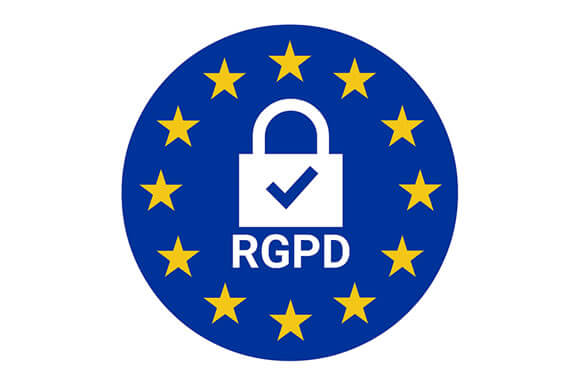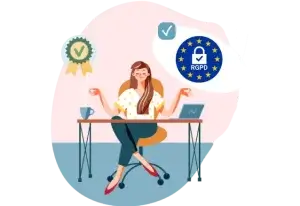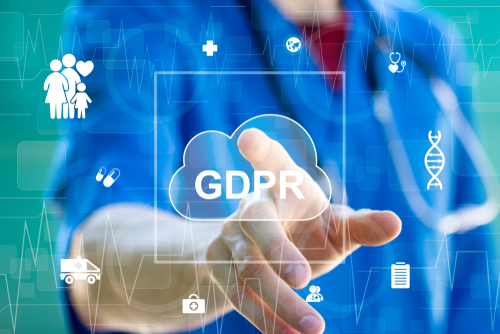The General Data Protection Regulation (GDPR) has become a pivotal factor in the privacy and data security landscape within the European Union and beyond. Its implementation in May 2018 marked a significant shift in how personal data should be handled, providing greater protection for individuals and imposing new obligations on businesses. This guide aims to demystify the process of selecting a GDPR compliance platform tailored to your company's specific needs, regardless of its size or industry.

Contextualizing the GDPR: Why is it Crucial?
The GDPR is designed to unify and strengthen data protection for everyone in the European Union. It imposes strict rules on the processing of personal data, thereby increasing transparency and strengthening individual rights. For businesses, this means that compliance is not only a legal obligation, but also an essential component of building trust and credibility with customers and business partners.
Importance of GDPR Compliance for Businesses
- Brand Protection: GDPR compliance enhances your company's image by demonstrating a serious commitment to data protection.
- Sanction Avoidance: Fines for non-compliance can be as high as 4% of global annual turnover or 20 million euros, whichever is higher.
- Competitive Advantage: Rigorous data management can become a competitive asset, distinguishing your company in the market.
Purpose of This Guide
The primary goal of this guide is to provide businesses with the knowledge and tools they need to choose the GDPR compliance platform best suited to their specific needs. Whether you're running a growth-stage startup or an established business with complex data flows, selecting the right platform is crucial to ensuring ongoing and effective GDPR compliance.
- Selection Criteria: We'll explore key features, evaluation criteria, and questions to ask when selecting a platform.
- Comparison of Platforms: An analysis of the main platforms on the market, their strengths, their weaknesses and who they are best suited for.
- Case Studies: Concrete examples of companies that have succeeded in their GDPR compliance thanks to an adequate platform.
By providing accurate, up-to-date, and well-researched information, this guide is intended to be a must-have resource for all businesses striving to navigate the complex landscape of GDPR compliance.
1- Understanding the GDPR
The General Data Protection Regulation (GDPR) establishes a strict legal framework governing the processing of personal data within the European Union (EU) and the European Economic Area (EEA). It aims to strengthen and unify data protection for individuals within these regions, while imposing new obligations on businesses and organizations. Understanding the basic principles, the requirements for businesses, and the consequences of non-compliance is essential to effectively navigate this regulatory landscape.
GDPR Basic Principles
The GDPR is based on seven fundamental principles which must guide the processing of personal data:
- Legality, loyalty and transparency: Data must be processed lawfully, fairly and transparently with respect to the data subject.
- Limitation of purposes: The data collected must be used only for specific, explicit and legitimate purposes.
- Data minimization: Only data necessary for the specified purposes should be collected and processed.
- Exactness : Data must be accurate and kept up to date.
- Retention limitation: Data should not be kept longer than necessary.
- Integrity and confidentiality: Data must be processed in a manner that ensures adequate security.
- Responsibility : The controller must be able to demonstrate compliance with the principles of the GDPR.
Requirements for Businesses
Companies must comply with a series of requirements to ensure the protection of personal data:
- Consent : Obtain explicit consent from individuals before processing their personal data.
- Rights of data subjects: Respect the rights of individuals, including the right to access, rectification, erasure, and data portability.
- Data protection by design and by default: Integrate data protection measures into the design of systems and services.
- Data Breach Notification: Inform the relevant authorities and data subjects in the event of a data breach.
- Data Protection Impact Assessment (DPIA): Carry out an EIPD for processing likely to present high risks to the rights and freedoms of individuals.
- Data Protection Officer (DPO): Appoint a DPO in certain cases to oversee GDPR compliance.
Consequences of Non-compliance
Penalties for non-compliance with GDPR can be severe:
- Fines: Companies can be fined up to 4% of their annual worldwide turnover or €20 million, whichever is higher.
- Reputation : Violations can cause significant damage to a company's reputation, leading to a loss of trust from customers and partners.
- Disputes: Non-compliance may also lead to litigation and claims for damages from affected individuals.
Ensuring GDPR compliance is not only a legal obligation, but also an opportunity to build trust with your customers and secure your corporate reputation. By taking a proactive approach and fully understanding the GDPR's requirements, businesses can successfully navigate this complex regulatory landscape.
2- Selection Criteria for a GDPR Compliance Platform
Choosing the right GDPR compliance platform for your business is crucial to ensuring compliance with data protection regulations and building customer trust. This process involves understanding the essential features a platform should offer, knowing how to evaluate vendors, and objectively comparing available options.
Essential Features
An effective GDPR compliance platform should integrate a set of key features to meet regulatory requirements and your specific business needs:
- Consent management: Tools to obtain, manage and document user consent in a compliant manner.
- Data subject rights management: Ability to respond to user requests regarding their rights (access, rectification, deletion, etc.).
- Personal data tracking: Tools to map and track the flow of personal data across the organization.
- Data Protection Impact Assessment (DPIA): Features to perform and manage EIPDs required for risky treatments.
- Data Breach Notification: Mechanisms to detect, report and notify data breaches within prescribed timeframes.
- Training and awareness: Resources for training staff on GDPR compliance practices.
Supplier Assessment
Evaluating GDPR compliance platform providers requires a methodical approach:
- Reputation and Reliability: Search for reviews, testimonials and case studies from existing customers.
- Compliance and Certification: Check if the supplier follows industry standards and has relevant certifications.
- Support and Customer Service: Evaluate the quality of technical support and consulting services offered.
- Updates and Scalability: Ensure the platform can adapt to regulatory changes and the growing needs of your business.
- System Integration: Review the platform's compatibility with existing systems and processes.
Comparison of Options
While it is essential not to promote a specific product, providing a comparative overview helps contextualize the decision:
- Platform A
- Platform B
- Platform C
Can stand out for its robustness in consent management and system integration, ideal for companies with complex IT infrastructures.
Strong on data subject rights management and training, recommended for organizations focusing on internal GDPR awareness.
Offers advanced solutions for data protection impact assessment and breach notification, suitable for highly regulated industries.
Checking References and Reviews
Feedback from other companies is crucial in assessing the effectiveness and reliability of a GDPR compliance platform.
- Read Customer Reviews: Online reviews can provide insights into user experience, customer support, and platform effectiveness.
- Study the Case Studies: Case studies highlight specific compliance challenges the platform has helped solve, providing perspective on its ability to meet your needs.
- Request References: Don't hesitate to ask the supplier for references from customers similar to your company to get direct feedback on their experience.
By following these steps—analyzing your specific needs, requesting demos and free trials, and checking references and reviews—you'll be well-positioned to choose the GDPR compliance platform that best suits your business. This methodical process not only ensures that the selected platform meets your compliance needs, but also integrates seamlessly into your existing operations, strengthening your GDPR compliance posture effectively and sustainably.
3- Steps to Choosing the Right GDPR Compliance Platform
Selecting the right GDPR compliance platform for your business is a process that requires diligence and attention. Here's a step-by-step guide to help you navigate this process, ensuring the solution you choose meets your company's unique compliance needs.
Needs Analysis
Before you begin your research, it is essential to understand your business's specific GDPR compliance needs.
- Evaluate Data Processing Processes: Identify how and where your business collects, stores, uses and shares personal data.
- Identify Compliance Gaps: Identify areas where your business needs to improve its GDPR compliance practices.
- Define Compliance Objectives: Clarify what you want to achieve with a GDPR compliance platform (e.g., automating consent management, facilitating data subject requests, etc.).
- Prioritize Features: Create a list of must-have and desirable features based on your compliance needs.
Request a Demo and Free Trial
Once you have a clear idea of what you need, the next step is to evaluate the platforms directly.
- Request Demonstrations: Demos allow you to see the platform in action and ask specific questions about features and integration.
- Take advantage of Free Trials: Many vendors offer trial periods that allow you to test the platform in your real-world environment, providing valuable insight into its usefulness and ease of use.
Checking References and Reviews
Feedback from other companies is crucial in assessing the effectiveness and reliability of a GDPR compliance platform.
- Read Customer Reviews: Online reviews can provide insights into user experience, customer support, and platform effectiveness.
- Study the Case Studies: Case studies highlight specific compliance challenges the platform has helped solve, providing perspective on its ability to meet your needs.
- Request References: Don't hesitate to ask the supplier for references from customers similar to your company to get direct feedback on their experience.
By following these steps—analyzing your specific needs, requesting demos and free trials, and checking references and reviews—you'll be well-positioned to choose the GDPR compliance platform that best suits your business. This methodical process not only ensures that the selected platform meets your compliance needs, but also integrates seamlessly into your existing operations, strengthening your GDPR compliance posture effectively and sustainably.
4- Implementation and Use of the Platform
Once you've selected the ideal GDPR compliance platform for your business, the next step is to effectively integrate it into your business processes, train your teams on its use, and develop strategies to maintain and update your compliance over time. Here's a guide to help you navigate these crucial steps.
Platform Integration
Successfully integrating your GDPR compliance platform into existing business processes is essential to maximize its effectiveness and value.
Start by developing a detailed integration plan that identifies the existing systems the platform needs to integrate with, the teams involved, and timelines.
Ensure close collaboration between IT, legal, and operational departments to ensure seamless integration.
Perform extensive testing to identify and resolve integration issues before full deployment.
Team Training
Training teams on how to use the platform effectively is crucial to ensuring that GDPR compliance processes are well understood and applied across the organization.
Implement comprehensive training programs that cover key platform features and GDPR compliance best practices.
Schedule regular training sessions to keep teams informed of regulatory updates and new platform features.
Provide online resources, such as video tutorials and FAQs, to allow users to learn at their own pace.
Compliance Monitoring and Update
Maintaining GDPR compliance is an ongoing process. Use your platform to monitor, update, and improve your compliance practices over time.
- Continuous Monitoring: Use the platform's monitoring and reporting tools to track the effectiveness of your compliance practices and identify areas for improvement.
- Regular Updates: Ensure your platform is regularly updated to stay compliant with the latest GDPR regulations and best practices.
- Regular Assessment: Schedule regular compliance assessments to review processes, policies, and training, and make necessary adjustments.
By following these tips for onboarding, training, and compliance monitoring, your business can maximize the benefits of your GDPR compliance platform and ensure lasting and effective compliance.
Conclusion
At the end of this comprehensive guide on selecting the right GDPR compliance platform for your business, we've explored the various essential aspects that contribute to an informed decision. From analyzing your business's specific needs and evaluating a platform's must-have features to effectively integrating and utilizing it, each step plays a crucial role in ensuring robust and lasting GDPR compliance.
Summary of Key Points:
- Understanding GDPR and its implications for your business is the first step towards compliance.
- Identifying the essential features that meet your specific business needs makes the selection process easier.
- Evaluating vendors based on their reputation, customer support, and integration capabilities ensures a reliable partnership.
- Integrating the platform into your existing processes, training teams and regularly monitoring compliance are essential to fully exploit your platform.
By taking the time to follow the tips and steps outlined in this guide, you will be well positioned to choose a GDPR compliance platform that not only meets regulatory requirements but also supports your business's long-term goals.
Now that you're armed with the knowledge you need to navigate the complex landscape of GDPR compliance, we encourage you to take the steps to choose the platform that best aligns with your business goals and needs. GDPR compliance isn't just a regulatory requirement; it's an opportunity to build customer trust and protect your company's reputation.

Question about GDPR Compliance and Platform Selection
Even small businesses process personal data and are therefore subject to the GDPR. Compliance helps avoid penalties and build trust with customers.
Not necessarily. The important thing is that the platform is GDPR compliant, offers the necessary features for your compliance, and ensures adequate protection of data transferred outside the EU.
Costs vary depending on features, the size of your business, and the level of customization required. Many providers offer flexible plans to suit different budgets.
Choose a platform that is committed to updating its features in line with legislative changes and offers ongoing support to help you navigate these developments.







